Views: 0
Eat More Whole Fruits and Vegetables, Meats, Beans, & Nuts, and Eat Less White Bread, White Rice, Soda, Juice, Candy, & Processed Foods

The Essential Info
Studies have shown that a low-glycemic diet may help reduce acne.
To eat a low-glycemic diet:
Eat More: Unprocessed, low-sugar, whole foods like meat/poultry/fish, vegetables, whole fruits, nuts, beans, oil, and eggs
Eat Less: Processed, high-sugar foods like white bread, white rice, pretzels/crackers, candy, soda, and fruit juices

The Science
Several scientific studies have recently shown that eating a low-glycemic diet, which includes foods that do not cause large increases in blood sugar levels, may help reduce acne symptoms.1-3 This article will explain what a low-glycemic diet entails and discuss tips for selecting foods that are low glycemic.
If you just want to get quick tips, scroll through and look for the red TIPS.
Low-glycemic foods
Low-glycemic foods are foods that do not cause a large increase in blood sugar, and include unprocessed, whole foods such as:
- Vegetables
- Whole fruits
- Nuts
- Beans
- Meat/Fish
- Eggs
- Oils
- Cheese
High-glycemic foods
High-glycemic foods are foods that cause a large increase in blood sugar, and often include processed foods such as:
- White bread
- White rice
- White potatoes
- Soda
- Juice
- Pretzels/Crackers/Rice cakes
- Candy
IMPORTANT NOTE: Just changing your diet will probably not completely clear up acne, but there is a possibility that it may help. Be realistic when attempting to eat lower glycemic. Look for some improvement–and keep in mind that this may be a small improvement.
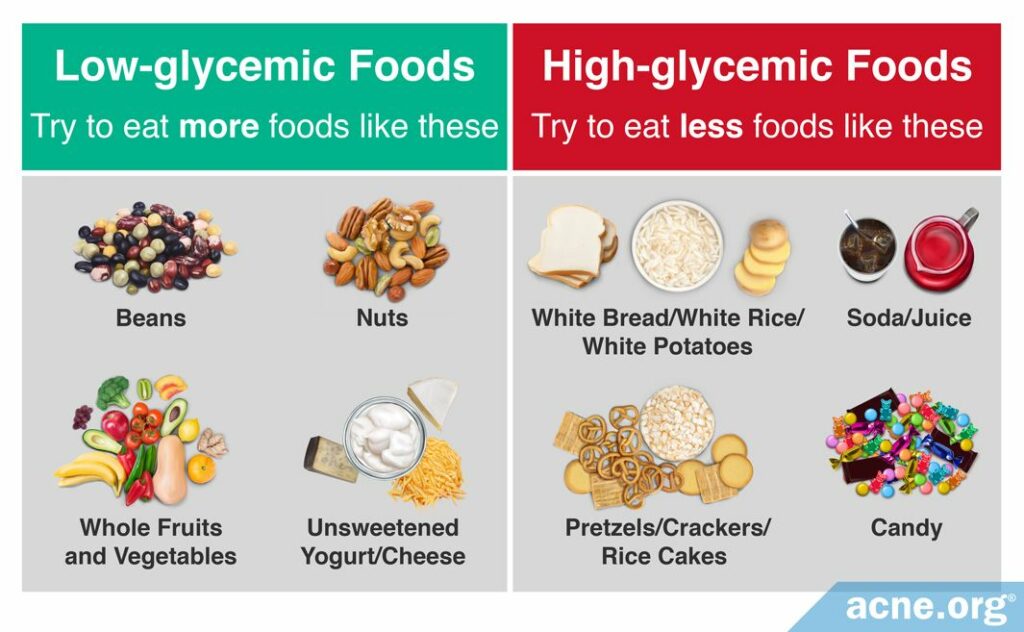
Examples of Low-glycemic Meals and Snacks
TIP: Here are some examples of low-glycemic meals and snacks:
- Breakfast: Omelet with feta cheese and tomatoes, bacon or sausage, and a side of fresh strawberries
- Lunch: Chicken or tuna salad on top of a salad of mixed greens and vegetables, topped with olive oil and balsamic vinegar
- Dinner: Chicken breast or fish, bean medley, and roasted vegetables
- Snack: A handful of nuts, baby carrots with hummus, or celery with peanut butter
- Dessert: Baked apple rings topped with cinnamon and lemon, or plain Greek yogurt with fresh blueberries
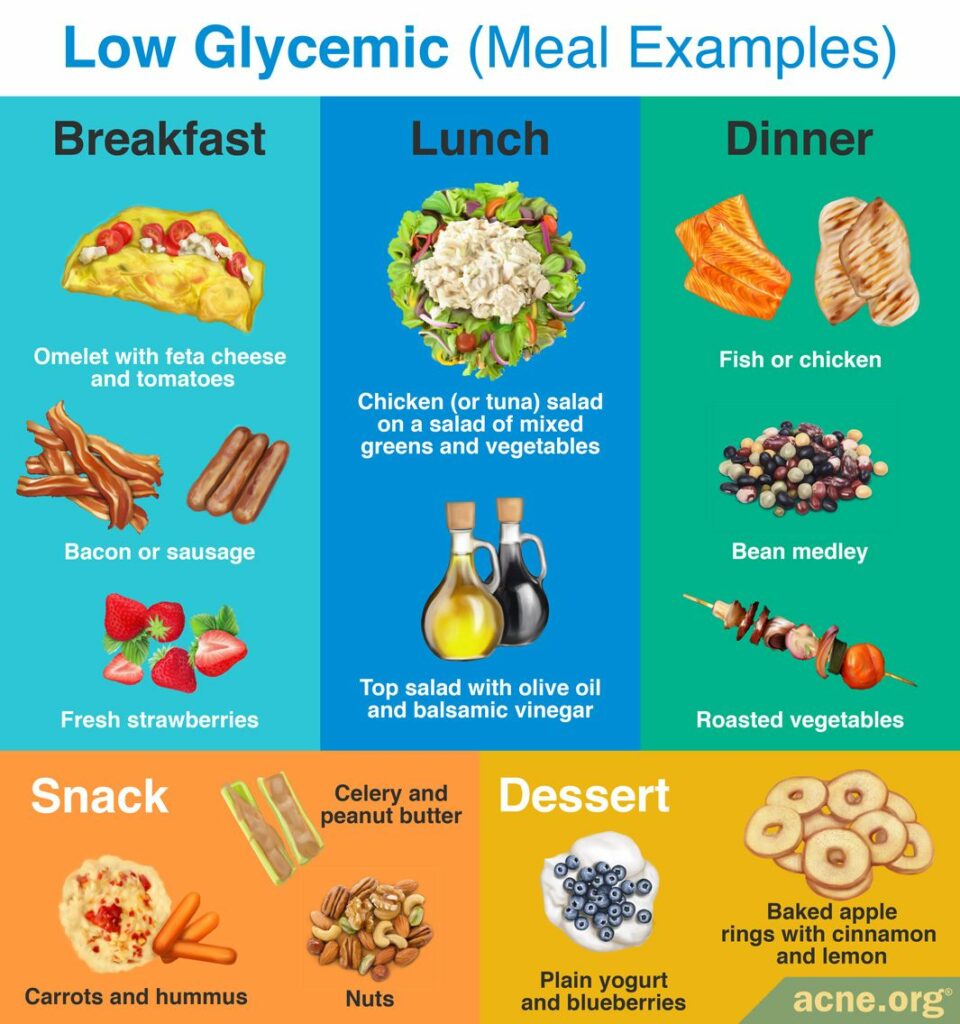
Tips for Including Low-glycemic Foods in Your Diet
TIP: Pick foods like beef, pork, poultry, fish, eggs, avocados, green leafy vegetables, peppers, berries, plums, peaches, grapefruit, and cheese. These are great options for a low-glycemic diet because they cause only small increases in blood sugar levels, even when they are eaten in large amounts.
TIP: Eat small amounts of high-glycemic foods. You can still achieve a low-glycemic diet when you include small amounts of high-glycemic foods.
TIP: Consult a glycemic table to verify the glycemic index and glycemic load per serving. If you are not sure whether a food is low glycemic or high glycemic, search that food on a glycemic table to determine the food’s glycemic value.
TIP: Balance glycemia by combining foods. If you are eating a high-glycemic food like pasta, incorporate a low-glycemic food like meat sauce, which contains nutrients such as fats and proteins. This can help balance the meal’s glycemic effect.
TIP: Do not assume that one food will always be low glycemic or high glycemic. Imagine that you have two packages of plain sugar cookies made by two different companies. Even though these cookies may look and taste the same, one cookie could be lower glycemic than the other cookie. The same type of food can be low glycemic or high glycemic, depending on the food’s:
- Ingredients: For example, if one cookie is made with white wheat flour, it will be higher glycemic than a cookie made with coconut flour.5
- How it is prepared: For example, if you bake a sweet potato, it will be higher glycemic than if you boil that same sweet potato.
- Where it comes from: Foods that come from different countries are often dramatically different, even if they are sold under the same name. According to Powell et al., “Kellogg’s Special K breakfast cereal is a very different product in North America (Kellogg Canada Inc) than in Australia (Kellogg, Sydney, Australia), each of which has a different GI value.”5
When you are selecting foods for a diet to reduce acne, consider what ingredients are used, how each food is prepared, and where the food originates from so you can determine whether a food is low glycemic or high glycemic.
Expand to read how high-glycemic foods raise blood sugar and may aggravate acne
Even though there are currently not enough studies to draw conclusions about the relationship between eating low glycemic and acne, the preponderance of the evidence at this point sways toward a high-glycemic diet making acne worse.
High-glycemic foods cause large increases in blood sugar levels over a short period of time, and while research is still not conclusive, this may promote a worsening of acne symptoms.
As discussed earlier, when blood sugar levels increase drastically in a short period of time, the body initiates a cascade of hormones and molecules.
1. The organ called the pancreas increases production of insulin, which is a hormone that helps the body use the sugar for energy or store the sugar as fat so it can be used for energy later. More insulin is thought to correlate with more acne.
2. Increases in the amount of insulin in the body lead to an increase in another hormone called insulin-like growth factor 1 (IGF-1). Increased IGF-1 levels are also thought to lead to increased acne.
3. When the amount of insulin in the body increases, a decrease in a molecule called IGFBP-3 ensues. The job of IGFBP-3 is to attach to insulin and render it inactive. So, the less IGFBP-3 you have, the more insulin is able to damage the body.
Recent studies have shown that higher levels of insulin and IGF-1 may increase acne by:
- Stimulating the production of skin cells, which can bring about clogged pores.
- Increasing the availability of androgens (male hormones present in both males and females). Androgens increase sebum (skin oil) production when active, and this contributes to the formation of acne.3
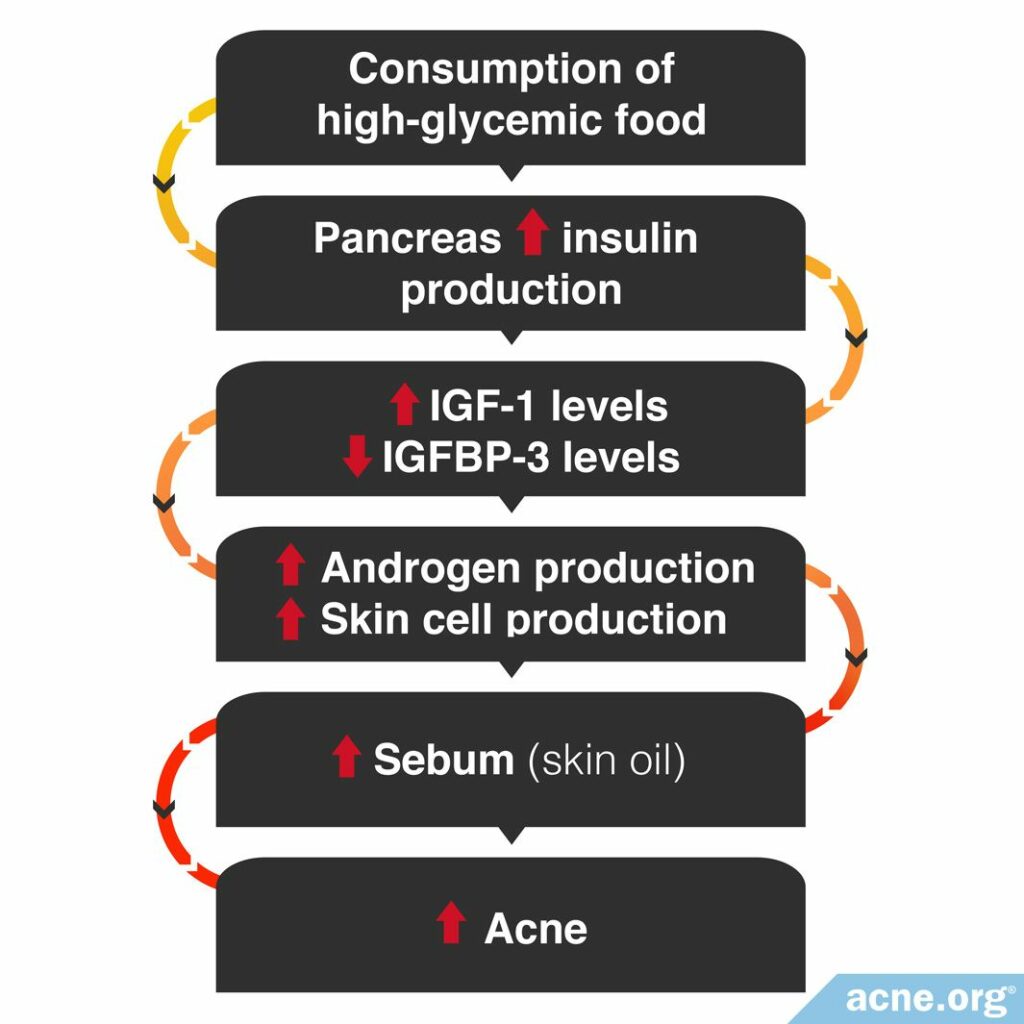
Studies Show Low-glycemic Diets May Reduce Acne
An increasing number of professionals are recommending a lower-glycemic diet to help reduce acne. This idea is based on the following evidence.6-12

In a 2007 study in The American Journal of Clinical Nutrition, researchers assigned 43 males (aged 15 – 25) either a low- or high-glycemic diet for 12 weeks. They found that participants who followed a low-glycemic diet showed a decrease in total acne compared with the males following the high-glycemic diet.6,7

The previous study also appeared in 2007 in the Journal of the American Academy of Dermatology.7
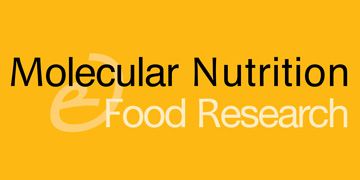
In a 2008 study in Molecular Nutrition & Food Research, researchers gave 12 males (aged 15 – 20) either a low- or high-glycemic diet. After only one week, the males on the low-glycemic diet had less androgens and increased IGFBP-3 in relation to the males following the high-glycemic diet. The increased IGFBP-3 – reduced IGF-1 activity reduced acne.8
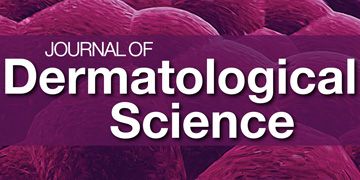
In a 2008 study in the Journal of Dermatological Science, researchers gave 31 males (aged 15 – 25) either high- or low-glycemic diets for 12 weeks. They found that, in males on the low-glycemic diet, both total acne and sebum production were reduced.9

A 2012 study published in the journal Acta Dermato-Venereologica and conducted with 32 Korean subjects (24 men and 8 women, aged 20 – 27) randomly assigned participants either high- or low-glycemic diets for 10 weeks. The participants given the low-glycemic diet showed reduced acne severity and reduced sebaceous (sebum-producing) gland size.10

A 2016 study published in the Journal of the American Academy of Dermatology tracked the dietary habits of 50 people with acne and 36 people without acne over a week. The participants kept food diaries for seven days. The scientists found that participants with acne consumed a higher-glycemic diet compared to participants without acne. In addition, the participants with moderate or severe acne consumed a higher-glycemic diet than participants with mild acne. They wrote, “A high-glycemic-index/-load diet was positively associated with acne vulgaris.”11

A 2018 study published in the Journal of the Academy of Nutrition and Dietetics asked 34 people with acne to eat a low-glycemic diet while 32 other people with acne continued to consume their usual diet. After two weeks, the researchers found reduced IGF-1 levels in the people who ate a low-glycemic diet. They speculated that over a longer period of time, the reduced IGF-1 levels might translate into less acne for the people on the low-glycemic diet.12
Some Studies Find No Connection Between Glycemic Load and Acne
On the other hand, three studies have found no connection between eating a low-glycemic diet and improving acne. Each of these studies had limitations, such as using unreliable methods for collecting data, testing diets for only a short time, or treating acne with medication and with diet changes at the same time.13-15

In a 2007 study published in the Journal of the American Academy of Dermatology, researchers compared the diets of 49 people with acne and 42 people without acne. They found no connection between glycemic load and the presence of acne. In other words, they did not see people with acne eating a higher glycemic load diet compared to people without acne. However, their findings were based on questionnaires completed by the participants, which is not a very reliable form of obtaining data.13
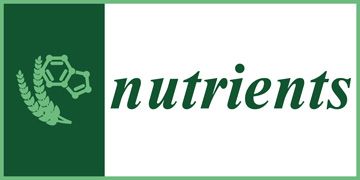
In a 2010 study published in the journal Nutrients, scientists assigned 58 teen males to either a high- or low-glycemic load diet for eight weeks. The researchers made sure the nutrient content of both diets was the same. They found that acne improved equally on both diets – in other words, the high glycemic load diet was just as beneficial as the low glycemic load diet. The scientists concluded that a longer period of time and/or a larger difference in glycemic load between the two diets might have revealed a difference in acne.14
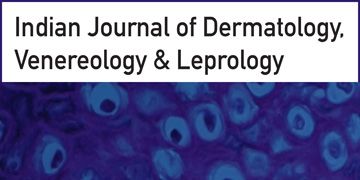
In a 2019 study published in the Indian Journal of Dermatology, Venereology and Leprology, researchers treated people with acne with benzoyl peroxide gel and at the same time placed them on different diets. Out of 84 participants with acne, half were asked to eat a low-glycemic diet for 12 weeks, while the other half followed their usual eating habits. At the end of 12 weeks, the researchers found acne equally reduced in both groups. They concluded that benzoyl peroxide had such a strong anti-acne effect that any additional benefit from eating a low-glycemic diet was negligible. However, the researchers noted that the potential anti-acne effect of a low-glycemic diet by itself is worth studying further.15
TIP: While we do have some evidence suggesting that low-glycemic diets help reduce acne, it is unlikely that changing your diet will resolve your acne. It is still important to consider proven treatments if you have acne.
What Else to Consider for a Healthy Diet
While the tips given in this article are helpful for learning how to eat low glycemic, there are many other factors to consider for a healthy diet.
TIP: The glycemic index does not provide information about important nutrients your body needs, such as fat, protein, fiber, and vitamins. As such, people should refer to the glycemic index in combination with eating colorful fruits and vegetables and high fiber foods.
TIP: In 2002, researchers published an international table of the glycemic index and glycemic load for almost 1300 different foods.5 To know the exact glycemic index or glycemic load of a certain food, please consult the table here.
Conclusion
Some studies have shown that there might be a relationship between the glycemic load of a diet and acne: a low-glycemic diet has been shown to improve acne in certain studies.
The general rule when eating a low-glycemic diet is to keep portions of processed, high glycemic index foods small and to instead eat unprocessed, whole foods that contain little or no carbohydrates, such as meat, poultry, fish, vegetables, fruit, beans, cheese, oils, or eggs.
To know the glycemic index or load of a particular food, consult this table for the exact value.
References
- Burris, J., Rietkerk, W. & Woolf, K. Acne: the role of medical nutrition therapy. J Acad Nutr Diet 113, 416 – 430 (2013). https://www.ncbi.nlm.nih.gov/pubmed/23438493
- Zaenglein, A. L. et al. Guidelines of care for the management of acne vulgaris. J Am Acad Dermatol 74, 945 – 973 (2016). https://www.ncbi.nlm.nih.gov/pubmed/26897386
- Bronsnick, T., Murzaku, E. C. & Rao, B. K. Diet in dermatology: Part I. Atopic dermatitis, acne, and nonmelanoma skin cancer. J Am Acad Dermatol 71, 1039 (2014). https://www.ncbi.nlm.nih.gov/pubmed/25454036
- Venn, B. J. & Green, T. J. Glycemic index and glycemic load: measurement issues and their effect on diet-disease relationships. Eur J Clin Nutr 61, S122 – S131 (2007). https://www.ncbi.nlm.nih.gov/pubmed/17992183
- Foster-Powell, K., Holt, S. H. & Brand-Miller, J. C. International table of glycemic index and glycemic load values: 2002. Am J Clin Nutr 76, 5 – 56 (2002). https://www.ncbi.nlm.nih.gov/pubmed/12081815
- Smith, R. N., Mann, N. J., Braue, A., Makelainen, H. & Varigos, G. A. A low-glycemic-load diet improves symptoms in acne vulgaris patients: A randomized controlled trial. Am J Clin Nutr 86, 107 – 115 (2007). https://www.ncbi.nlm.nih.gov/pubmed/17616769
- Smith, R. N., Mann, N. J., Braue, A., Makelainen, H. & Varigos, G. A. A low-glycemic-load diet versus a conventional, high-glycemic-load diet on biochemical parameters associated with acne vulgaris: A randomized, investigator-masked, controlled trial. J Am Acad Dermatol 57, 247 – 256 (2007). https://www.ncbi.nlm.nih.gov/pubmed/17448569
- Smith, R. N. et al. A pilot study to determine the short-term effects of a low glycemic load diet on hormonal markers of acne: A nonrandomized, parallel, controlled feeding trial. Mol Nutr Food Res 52, 718 – 726 (2008). https://www.ncbi.nlm.nih.gov/pubmed/18496812
- Smith, R. N., Braue, A., Varigos, G. & Mann, N. J. The effect of a low glycemic load diet on acne vulgaris and the fatty acid composition of skin surface triglycerides. J Dermatol Sci 50, 41 – 52 (2008). https://www.ncbi.nlm.nih.gov/pubmed/18178063
- Kwon, H. H. et al. Clinical and histological effect of a low glycaemic load diet in treatment of acne vulgaris in Korean patients: a randomized, controlled trial. Acta Derm Venereol 92, 241-6 (2012). https://pubmed.ncbi.nlm.nih.gov/22678562/
- Çerman, A. A., Aktaş, E., Altunay, İ. K., Arıcı, J. E., Tulunay, A. & Ozturk, F. Y. Dietary glycemic factors, insulin resistance, and adiponectin levels in acne vulgaris. J Am Acad Dermatol 75, 155 – 162 (2016). https://www.ncbi.nlm.nih.gov/pubmed/27061046
- Burris, J., Shikany, J. M., Rietkerk, W., Woolf, K. A Low glycemic index and glycemic load diet decreases Insulin-like Growth Factor-1 among adults with moderate and severe acne: A short-duration, 2-week randomized controlled trial. J Acad Nutr Diet 118, 1874 – 1885 (2018). https://www.ncbi.nlm.nih.gov/pubmed/29691143
- Kaymak, Y., Adisen, E., Ilter, N., Bideci, A., Gurler, D. & Celik, B. Dietary glycemic index and glucose, insulin, insulin-like growth factor-I, insulin-like growth factor binding protein 3, and leptin levels in patients with acne. J Am Acad Dermatol 57, 819 – 823 (2007). https://www.ncbi.nlm.nih.gov/pubmed/17655968
- Reynolds, R. C., Lee, S., Choi JY, et al. Effect of the glycemic index of carbohydrates on Acne vulgaris. Nutrients 2, 1060 – 1072. (2010). https://www.ncbi.nlm.nih.gov/pubmed/22253996
- Pavithra, G., Upadya, G. M. & Rukmini, M. S. A randomized controlled trial of topical benzoyl peroxide 2.5% gel with a low glycemic load diet versus topical benzoyl peroxide 2.5% gel with a normal diet in acne (grades 1-3). Indian J Dermatol Venereol Leprol 85, 486 – 490 (2019). https://www.ncbi.nlm.nih.gov/pubmed/30264745
The post Tips on How to Eat Low Glycemic appeared first on Acne.org.

